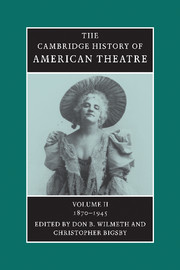Book contents
- Frontmatter
- Introduction
- Timeline: Post-Civil War to 1945
- 1 The Hieroglyphic Stage: American Theatre and Society, Post-Civil War to 1945
- 2 A Changing Theatre: New York and Beyond
- 3 Plays and Playwrights
- 4 Theatre Groups and Their Playwrights
- 5 Popular Entertainment
- 6 Musical Theatre
- 7 Actors and Acting
- 8 Scenography, Stagecraft, and Architecture
- 9 Directors and Direction
- Bibliography
- Index
7 - Actors and Acting
Published online by Cambridge University Press: 28 March 2008
- Frontmatter
- Introduction
- Timeline: Post-Civil War to 1945
- 1 The Hieroglyphic Stage: American Theatre and Society, Post-Civil War to 1945
- 2 A Changing Theatre: New York and Beyond
- 3 Plays and Playwrights
- 4 Theatre Groups and Their Playwrights
- 5 Popular Entertainment
- 6 Musical Theatre
- 7 Actors and Acting
- 8 Scenography, Stagecraft, and Architecture
- 9 Directors and Direction
- Bibliography
- Index
Summary
Introduction
The period from the end of the Civil War to the onset of the Great Depression was the most dynamic in the history of the American stage. General economic prosperity and expanding urban populations fueled a demand for theatrical entertainment and an ever greater number of actors. Emerging young talents overlapped waning older stars. Traditional and new acting approaches and dramatic material jockeyed for audience attention and critical recognition. The acting profession, long held in disrepute, gradually attained an unprecedented level of social respectability. For the acting profession, it was a dynamic, progressive time, although not without significant organizational and artistic tensions and conflicts. Since other essays in this volume describe how organizational changes – the long run, touring combinations, managerial monopolies, and so forth – affected actors, this chapter concentrates principally on signal developments within the acting profession, on shifts in acting style, and on the leading, most celebrated actors of the era.
The Gilded Age: 1870–1915
The Profession Expands
After the Civil War, the number of actors steadily increased. The 1870 census reported two thousand actors and actresses; by 1890 this figure had grown almost fivefold. By 1912 there were more than fifteen thousand actors (see Winter, Wallet of Time, I, 28). This figure probably included only legitimate performers. If one adds professional showpeople – dancers, circus performers, and variety artists – there were possibly as many as thirty to forty thousand employed in some form of theatre or popular entertainment at the turn of the century.
- Type
- Chapter
- Information
- The Cambridge History of American Theatre , pp. 446 - 486Publisher: Cambridge University PressPrint publication year: 1999
- 2
- Cited by



